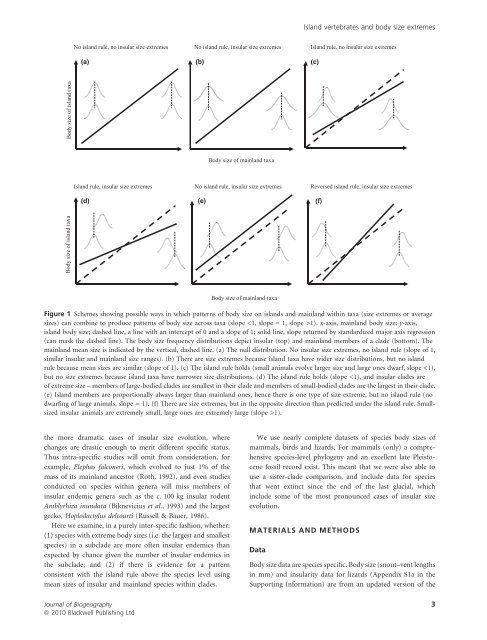Slaying dragons: limited evidence for unusual body size evolution ...
Slaying dragons: limited evidence for unusual body size evolution ...
Slaying dragons: limited evidence for unusual body size evolution ...
You also want an ePaper? Increase the reach of your titles
YUMPU automatically turns print PDFs into web optimized ePapers that Google loves.
Body <strong>size</strong> of island taxa<br />
Body <strong>size</strong> of island taxa<br />
No island rule, no insular <strong>size</strong> extremes<br />
the more dramatic cases of insular <strong>size</strong> <strong>evolution</strong>, where<br />
changes are drastic enough to merit different specific status.<br />
Thus intra-specific studies will omit from consideration, <strong>for</strong><br />
example, Elephas falconeri, which evolved to just 1% of the<br />
mass of its mainland ancestor (Roth, 1992), and even studies<br />
conducted on species within genera will miss members of<br />
insular endemic genera such as the c. 100 kg insular rodent<br />
Amblyrhiza inundata (Biknevicius et al., 1993) and the largest<br />
gecko, Hoplodactylus delcourti (Russell & Bauer, 1986).<br />
Here we examine, in a purely inter-specific fashion, whether:<br />
(1) species with extreme <strong>body</strong> <strong>size</strong>s (i.e. the largest and smallest<br />
species) in a subclade are more often insular endemics than<br />
expected by chance given the number of insular endemics in<br />
the subclade; and (2) if there is <strong>evidence</strong> <strong>for</strong> a pattern<br />
consistent with the island rule above the species level using<br />
mean <strong>size</strong>s of insular and mainland species within clades.<br />
No island rule, insular <strong>size</strong> extremes<br />
(a) (b) (c)<br />
Body <strong>size</strong> of mainland taxa<br />
Island rule, insular <strong>size</strong> extremes No island rule, insular <strong>size</strong> extremes<br />
(d) (e) (f)<br />
Body <strong>size</strong> of mainland taxa<br />
We use nearly complete datasets of species <strong>body</strong> <strong>size</strong>s of<br />
mammals, birds and lizards. For mammals (only) a comprehensive<br />
species-level phylogeny and an excellent late Pleistocene<br />
fossil record exist. This meant that we were also able to<br />
use a sister-clade comparison, and include data <strong>for</strong> species<br />
that went extinct since the end of the last glacial, which<br />
include some of the most pronounced cases of insular <strong>size</strong><br />
<strong>evolution</strong>.<br />
MATERIALS AND METHODS<br />
Data<br />
Island vertebrates and <strong>body</strong> <strong>size</strong> extremes<br />
Island rule, no insular <strong>size</strong> extremes<br />
Reversed island rule, insular <strong>size</strong> extremes<br />
Figure 1 Schemes showing possible ways in which patterns of <strong>body</strong> <strong>size</strong> on islands and mainland within taxa (<strong>size</strong> extremes or average<br />
<strong>size</strong>s) can combine to produce patterns of <strong>body</strong> <strong>size</strong> across taxa (slope 1). x-axis, mainland <strong>body</strong> <strong>size</strong>; y-axis,<br />
island <strong>body</strong> <strong>size</strong>; dashed line, a line with an intercept of 0 and a slope of 1; solid line, slope returned by standardized major axis regression<br />
(can mask the dashed line). The <strong>body</strong> <strong>size</strong> frequency distributions depict insular (top) and mainland members of a clade (bottom). The<br />
mainland mean <strong>size</strong> is indicated by the vertical, dashed line. (a) The null distribution. No insular <strong>size</strong> extremes, no island rule (slope of 1,<br />
similar insular and mainland <strong>size</strong> ranges). (b) There are <strong>size</strong> extremes because island taxa have wider <strong>size</strong> distributions, but no island<br />
rule because mean <strong>size</strong>s are similar (slope of 1). (c) The island rule holds (small animals evolve larger <strong>size</strong> and large ones dwarf, slope


